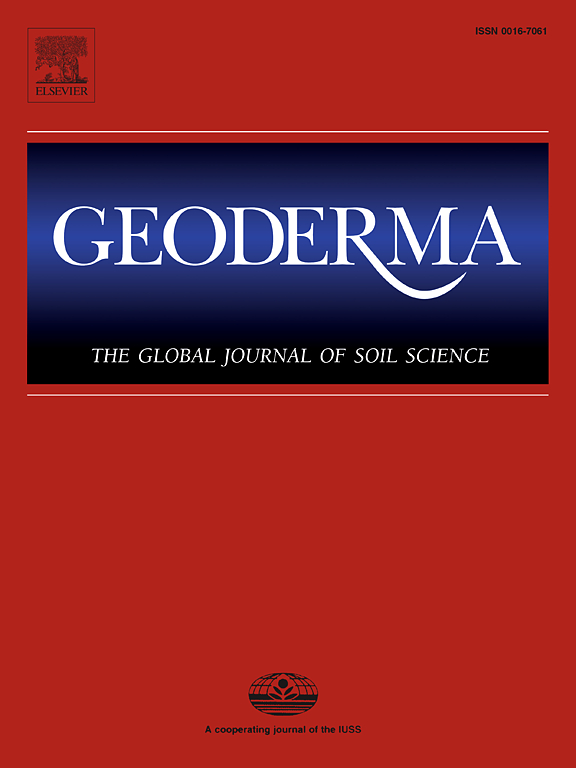土壤无机碳的可见近红外光谱集合与迁移学习
IF 5.6
1区 农林科学
Q1 SOIL SCIENCE
引用次数: 0
摘要
全球半干旱和干旱区土壤碳库以土壤无机碳(SIC)为主。碳化硅池的变化将大大影响大气中的二氧化碳浓度。利用可见近红外(Vis-NIR)光谱技术快速准确地测定土壤碳化硅含量,对半干旱和干旱区土壤碳库管理具有重要意义。集成学习是一种新颖而先进的建模方法。然而,它在土壤光谱中的应用较少,其传输能力也未得到评价。因此,我们假设使用集成技术可以提高SIC预测精度,并具有更好的模型传递能力。以新疆南部阿拉尔垦区990份土壤样品为研究对象,建立了土壤堆积模型。堆叠模型由10个基本模型(支持向量机(SVM)、偏最小二乘算法(PLSR)、多层感知机(MLP)等)组成。采用两种策略(超参数调整和非参数调整)将模型转移到中国南部边境的沙雅和温素县等其他目标地区。结果表明,采用叠层模型可以准确预测SIC含量(R2p = 0.81)。叠加模型的预测效果优于所有单独模型,显著提高了SIC的预测精度。叠加模型的R2p提高了0.05 ~ 0.21,均方根误差(RMSEP)降低了0.33 ~ 1.44 g kg−1。此外,叠加模型表现出较好的模型迁移能力。与直接传递模型相比,经过超参数微调的叠加模型具有更好的模型稳定性和泛化能力。与未调整超参数的叠加模型相比,平均R2p提高了0.09以上。综上所述,叠加集成学习是一种具有良好迁移能力的预测SIC的潜在方法。研究结果为半干旱区和干旱区SIC的准确估算提供了新的工具和策略。本文章由计算机程序翻译,如有差异,请以英文原文为准。
Ensemble and transfer learning of soil inorganic carbon with visible near-infrared spectra
Soil inorganic carbon (SIC) dominates the soil carbon pools in semi-arid and arid areas globally. Variations in the SIC pool would substantially affect the atmospheric CO2 concentrations. The rapid and accurate measurement of SIC content using visible near-infrared (Vis-NIR) spectroscopy is of high significance for the management of soil carbon pools in semi-arid and arid regions. Ensemble learning is a novel and advanced modeling approach. However, it has been applied less in soil spectroscopy, and its transfer capability has not been evaluated. Therefore, we hypothesized that the use of the ensemble technique could further SIC prediction accuracy and have a better model transfer capability. In this study, a stacking model was developed using 990 soil samples collected from the Alar Reclamation region in South Xinjiang, China. The stacking model consists of 10 base models (support vector machine (SVM), partial least squares algorithm (PLSR), multi-layer perceptron (MLP), etc.). Two strategies (hyperparameter-adjusted and −unadjusted) were used to transfer the model to other target areas including Shaya and Wensu Counties on the southern border of China. Our results demonstrate that the SIC content could be predicted accurately using the stacking models (R2p = 0.81). The stacking model outperformed all the individual models and significantly improved the prediction accuracy of SIC. The R2p of the stacking models improved by 0.05–0.21, and the root mean square error (RMSEP) reduced by 0.33–1.44 g kg−1. Additionally, the stacking models displayed superior model transfer capability. Compared with direct transfer, the stacking model with fine-tuning of the hyperparameters displayed better model stability and generalization. Moreover, the average R2p improved by over 0.09 compared with the stacking model with unadjusted hyperparameters. Overall, stacking ensemble learning is a potential method for predicting SIC with good transfer capabilities. Our results provide new tools and strategies for the accurate estimation of SIC in semi-arid and arid regions.
求助全文
通过发布文献求助,成功后即可免费获取论文全文。
去求助
来源期刊

Geoderma
农林科学-土壤科学
CiteScore
11.80
自引率
6.60%
发文量
597
审稿时长
58 days
期刊介绍:
Geoderma - the global journal of soil science - welcomes authors, readers and soil research from all parts of the world, encourages worldwide soil studies, and embraces all aspects of soil science and its associated pedagogy. The journal particularly welcomes interdisciplinary work focusing on dynamic soil processes and functions across space and time.
 求助内容:
求助内容: 应助结果提醒方式:
应助结果提醒方式:


